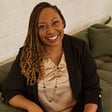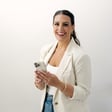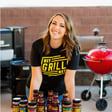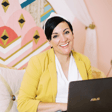Origins of Flowdesk
00:00:05
Speaker
It wasn't a choice for us to start Flowdesk. It had to happen, and we knew we were the only people in the world who could set out to solve this problem for this particular market, and it was like a calling. There was no option. We had to do this.
Introduction to Flowdesk Founders
00:00:22
Speaker
Welcome to the Brands That Book Show, where we help creative, service-based businesses build their brands and find more clients. I'm your host, Davy Jones.
00:00:33
Speaker
Martha and Rebecca, the founders of Flowdesk, joined me today for a conversation about email marketing and how Flowdesk came to be.
Entering a Saturated Market
00:00:41
Speaker
Flowdesk launched late last year, but in a short amount of time and has become a very popular email marketing platform, especially among creative professionals.
00:00:49
Speaker
I chat with Martha and Rebecca about what made them pursue building an email marketing platform, even though there are so many different options out there. I think anyone building a business, especially in a market where they feel it's saturated, where there are lots of other options, can benefit from listening to
Flowdesk's Appeal to Users
00:01:05
Speaker
this episode. If you haven't checked out Flowdesk, give it a try. If you've never done any email marketing before, I think you'll find it pretty intuitive to use. And if you have experience with email marketing, I think you'll find their email designer to be a breath of fresh air.
00:01:18
Speaker
Be sure to check out the show notes at DavyandChrista.com for the resources we mentioned during the episode. And I want to hear from you. Let me know what kind of content you'd like to see on the Brands at Book podcast as we move forward. To leave your feedback, head on over to the DavyandChrista Facebook page and send us a message. You can also send us a DM on Instagram at DavyandChrista. Now onto the episode.
00:01:41
Speaker
Welcome back for another episode of the Brands That Book Podcast. I am excited today because I have the founders of Flowdesk, both founders of Flowdesk, Martha and Rebecca, here to chat about how Flowdesk has been able to just take off.
00:01:57
Speaker
in the last 12 months. But it hasn't even been 12
Founders' Backgrounds and Meeting
00:02:00
Speaker
months, right guys? It's been five. It's been five. That's crazy to me, just because, you know, especially when I see in, I mean, a lot of different website design groups in particular, such as the show at user group. And nowadays, if somebody recommends or asked for a recommendation around email marketing platform, Flowdesk is one of the most recommended tools. And to think that you are only five months old is crazy to me.
00:02:25
Speaker
It's amazing. We can't believe it either, honestly. It's crazy.
00:02:29
Speaker
Yeah, so I'm excited to chat about how you all got started. And to be honest,
Entrepreneurial Journeys
00:02:33
Speaker
I think if you had said, Davey, six months ago, or eight months ago, or a year ago, whenever you were getting started with this, and you said, Davey, I'm thinking about starting a new email marketing platform. I think to be honest, I would have been, I think I would have expressed hesitancy. I would have said, all right, well, I mean, there's a ton of solutions out there, but it turns out that I would have been just completely wrong with any sort of hesitation.
00:02:57
Speaker
So David, we heard it. We heard it so we can get into these later, but we heard it so many times. Everyone would just look at us. And I think it was like the most common question we would get after that is say what, or can you repeat that? People would not believe that we were like super excited about building yet another email marketing platform.
00:03:17
Speaker
Yeah, so I'm really excited to hear about what made you think there was space in a market for another platform because there obviously is based on the amount of just growth that you all seen over the past five months. But we're jumping ahead. We typically start with every episode hearing a little bit about our guest entrepreneurial journey. So I'd love to hear about just how you all met and then how this idea came to be.
Rebecca's Creative Insights
00:03:43
Speaker
Okay, cool. Well, I like to talk about my journey is beginning basically when I got out of college because my first job out of college was a job at a company where I was working to make merchandising designs for
00:03:56
Speaker
Really big bands like Rihanna, Linkin Park, Cheryl Crow, and Alanis Morissette. And from that I sort of learned about how to be a commercial designer and design for a lot of different styles and also see the needs of a variety of different creatives and artists. From there I ended up, I fell in love with the creative industry.
00:04:13
Speaker
through a few turns of fate and I fell in love with making tools for the creative community.
Vision for the Creative Community
00:04:20
Speaker
So I've had several businesses in the past that created template libraries and galleries for professional photographers and creatives and I recently collaborated with Jenna Kutcher on her template shop. So the work that you see in that template shop offered by Jenna is the result of both of us working together and I'm just so super passionate about building
00:04:40
Speaker
tools for creatives that really help them to express themselves, to grow their business and to explore their creativity. I mean, it's just a privilege to do that. And so I think I'll let Martha jump in here about how we, the two of us came together, but
00:04:55
Speaker
We both came from very different backgrounds, but we met at this one convergence point about this love and this passion for the creative community and creating tools for them.
Identifying Market Gaps
00:05:05
Speaker
Did you hear the part where she used to design for Rihanna and Linkin Park? I didn't want to interrupt, but it definitely caught my attention.
00:05:15
Speaker
I didn't even find that out until maybe after we had started building Flownisk. And I'm like, oh, wow, that's super cool. So I have always been very entrepreneurial. I just never wanted to make it a business because I fear that, like I love building things and I love travel. And I always said, I'm not going to make a business out of either because then what if it gets rid of the excitement, right? So I would
00:05:40
Speaker
have these like moments where I would stay up all night because I would realize like, oh my gosh, the world needs these. So I would just build it like a crypto kitties blog, right with like instructions and how to breed kitties and do crypto online. And then I would just like leave it like pass it on to the world and then they could take it and flow desk was the first time that it made sense for it to become a business. And the reason is because we wanted to make it sustainable so we can continue serving our members but
00:06:07
Speaker
But more on that later. So I ended up creating brief entrepreneurial pursuits while having a full-time job. And Davey, that's where you and I met at Honeybook, where it probably was like my favorite being employed somewhere experience because it also felt like we were building the business together with founders and in growing the educator program where
00:06:31
Speaker
My job was to find creatives who were already educating other creatives and support them in building these educational businesses. It felt like running a small business within a business, right? So it was always really fun. But that's how I met you and that's also how I met Rebecca. So Rebecca and I originally connected because we wanted to do a partnership and then the partnership actually didn't
00:06:54
Speaker
make sense. So we decided not to do it, but we stayed friends. And then we would call on each other every time that we would have business ideas. I remember we decided we wanted to create a planner, a digital planner before and we would just go crazy with designs and slide decks. But it wasn't the right idea, right? And then there was a moment where my educators would come to me and they were telling me that they were struggling with email marketing.
00:07:23
Speaker
These are the people in the creative industry that have made it. They have millions of followers or tens of thousands and they know how to create courses and they know how to sell them. They've been doing something else for a while and they have clients. It was confusing to me.
00:07:42
Speaker
is someone who is so business savvy and able to figure this out. So my response was, oh, I have a friend. She's a designer. She can help you implement this in another tool. And when I went to Rebecca, she said, Martha, no. My number one support ticket with my current business where she would sell email templates is I love the template, but I have no idea how to use this in any of the tools out there. So we realized that there was a problem.
00:08:11
Speaker
Yeah, and so that's where you started exploring maybe the idea of creating your own platform.
00:08:16
Speaker
That is correct. I would actually argue that it wasn't an exploration of the idea. It was like we had the idea, and it was just a matter of timing to be able to put everything together, but it wasn't a choice for us to start Flowdesk.
Challenges with Existing Platforms
00:08:30
Speaker
It had to happen, and we knew we were the only people in the world who could set out to solve this problem for this particular market, and it was like a calling. There was no option. We had to do this.
00:08:42
Speaker
Yeah, so Rebecca, you were designing email templates already. Did they work for any platform? Were you designing templates for a specific platform? What did that support ticket usually look like when somebody came to you and said, okay, how do I implement your design in my platform?
00:08:57
Speaker
Yeah, that's a great question. Well, I would say that what it looks like is probably all capital letters. It probably had the word help in it with an A and it had the word refund at the bottom. So to give you an idea of what those emails look like, and they were pretty constant, the emails templates that I created were marketed for MailChimp.
00:09:17
Speaker
although they could be implemented in other platforms. And the templates were truly just text that you pasted in and some image files that you would edit in Photoshop, save out to your computer and then upload to the email marketing platform of choice. And the fact that that caused that much anxiety and created that many support tickets was just such a blaringly clear indicator that there was a huge underlying problem. And there was a segment of the market that these large email marketing companies were just not serving for one reason or another.
User-Centric Design Approach
00:09:46
Speaker
And I'm sure we'll get into this a bit later, but Martha and I had to do extensive research to figure out exactly what those pain points and problems were.
00:09:55
Speaker
What's interesting to me, and this is just, I guess this is an observation that I've thought about a ton, but Mailchimp seemed to be at one point sort of the dominant player and just kind of the de facto recommendation for people who are getting started with email marketing. My guess is because there was some sort of visual builder, and they had a free plan, right? And then you have something like ConvertKit come on the scene. And again, this is a huge oversimplification. I'm sure you all
00:10:21
Speaker
have a much bigger picture of this and who else is out there. But you have ConvertKit come along and they're not really trying to do what MailChimp was doing or at least that's my perception. They looked at, they have the full text builder or full text emails, right? And even in their helps documents, they're like, hey, this is why you should write maybe text emails versus more visually based emails.
00:10:43
Speaker
And then you will come in and it's almost like you're doing a little bit of both but that i don't think that would even be a fair assessment because i think you know on some level it's just very different than both of those as well but it's a visual builder that seems a lot easier to use for people than something like male champ.
00:11:01
Speaker
but also gives people maybe the same flexibility they were looking looking for in something like convert kit being able to create automations and sequences so you know i'd be interested just in how you determine really what to build.
00:11:16
Speaker
and how it was different purposely than some of these other platforms out there? Yeah, it's a great question. So it was a long process and I can break it down and I find that it's a very repeatable process. So no matter what you're building, you can pretty much apply this and validate your ideas and find out what you have to build.
Lean Startup Methodology
00:11:37
Speaker
But the first thing that we decided to do when we noticed that there are so many email marketing platforms that are popping up every single day, maybe every week, I don't know, but there's a lot of them. And every one of them builds upon the previous one, right? So they take a lot of what's already there and then they just make tweaks.
00:11:57
Speaker
And we were like you know what let's stop looking at what everyone else is doing so we did not use mailchimp we did not use convert we on purpose did not study the market because we didn't want to get biased and we said if we were creating this today if it didn't exist and we were just.
00:12:14
Speaker
fresh creating it today. What would it look like? How would it work? So that's the first thing that we had to do. We had to remove all the biases that we already had and make sure that we weren't carrying new biases by doing
User Testing and Iteration
00:12:27
Speaker
research. And then the second one, and there's a really, really good book that's called Lean Startup, and it breaks down the methodology, but it was doing a lot of use of research, understanding what pains they were experiencing, asking why five times,
00:12:43
Speaker
and then finding out why they were doing things the right or the wrong way and why that was causing pain so that we can build something that could address that pain. Yeah, one thing I want to, and I don't mean to interrupt, one thing I want to ask about, because I think it's just such an interesting point, is why you ask people multiple times why? Oh, yeah. So the reason, and there's a lot of research on these, is because the first time doesn't get you the real why. Sure. But we're kind of the other elements of exploring those ideas.
00:13:13
Speaker
It's funny because Oz, the CEO of HoneyBook, said when he started looking at how fast we were growing, he made a comment and observation. And Rebecca and I thought it was brilliant. And he said, you know how so many people talk about having product market fit where you have the right product for the right market? He said, what you have is founder market fit because you and Rebecca really, really know the market.
00:13:35
Speaker
And I think that was essential for us to really, really get to know exactly why our target customer was using email marketing, why they were having creative anxiety. What does that mean to them personally? So the next step was just to do a lot of research directly by having conversations with our target market. So I remember I would come home because I was still employed full time, right? So I would come home to Rebecca's house like 6pm or I would come home to my home and then go to Rebecca's house.
00:14:06
Speaker
My home is her home because it's kind of turned into that. Our home is blurred. We were working on these like day and night. And I would schedule like seven to 12 interviews like in person from 6pm until however long we can go. And we would just ask questions. At the beginning, it was just asking questions. And then we created what the book Lean Startup refers to as an MVP or minimum viable product. So it's the least
00:14:34
Speaker
effort that you can put into a product where you can put it in front of someone and ask them to use it so it was a
Focus on Templates
00:14:41
Speaker
wireframe right it was like a napkin sketch that then rebecca put into the screen we would ask everyone okay so if you were to send an email where would you click and then we would observe where the mouse would go naturally right and then via this observation we would know okay well intuitively they expect this button to be here right but
00:15:02
Speaker
But we were thinking of building it in these corners. So let's let's adjust that. So so what kicked in is we started building a product that was made exactly for the way that they think without them having to think about it. So one and I nerd out on this. So stop me if I'm if I'm going too deep into it. But our market like our generation and the generations of entrepreneurs are to come are digitally native. Right. Like we grew up with
00:15:28
Speaker
very early on, a phone on our hand. So the interface of the apps that we use every day is completely different from the interfaces that were built for men in tech, right? So that's what kicked in. It's how do we actually build something that's very intuitive that also removes everything that you don't need to see? Because one thing that the other platforms have as well is that you come in and you see everything that that platform can do.
00:15:54
Speaker
What is not related to the task that you have to do at that moment right so we were like let's turn everything into a flow how do we remove everything that you don't care about in this moment and only show you the next relevant step.
00:16:08
Speaker
And so, as you're getting started building this, at what point did you sort of settle on what it was going to look like? And Rebecca, I'd love to hear too just in terms of user testing or what you learned through user testing and what you kind of already intuitively knew based on the feedback that you were getting from your email templates. Yeah, that's a great question. Well, in full disclosure, Flowdesk is actually my first attempt at designing software. I think I did okay.
00:16:34
Speaker
Yeah, I would say that's an understatement. As somebody who's dabbled and had friends that have pursued software companies, I would say that yes, and that's an understatement. Thank you. But it's interesting because I actually come from more of a print background and my specialty has always been designing templates.
00:16:54
Speaker
Designing the software this time was almost more about designing around the templates rather than the other way around. I noticed that a lot of platforms out there, not just for email marketing but also for websites and designing things online where you can customize products,
00:17:11
Speaker
It feels like the platform itself was designed first, and then the templates were sort of an afterthought. But the truth is, the minimum viable product of Flowdesk was actually just email templates that we created in Photoshop and then sent out with our very bare-boned system.
00:17:30
Speaker
product was based around the concept of creating templates. And then we sort of built out the rest of the web app around these templates. And so I think that's why Flow Dust feels like this delightful editing experience, because that's really the piece that we focused on and tackled first, because that was kind of the pain point that we found out was really getting to people the
Continuous Feedback and Innovation
00:17:52
Speaker
As far as the process, I mean, it is so iterative and it's funny because when people log into Flowdesk, they see this product that's at their fingertips and it's a static screen and they go through the product and it just exists in its current form on their browser. But the truth is that if you looked at my computer, I probably have 12 to 15 different iterations of the designs for the platform because it's
00:18:15
Speaker
Yeah, it's just a living thing. There comes a point when you're designing something for a lot of people where you just have to have a lot of people in it in order to know whether your decisions are right. We did a lot of wireframe testing and that got us, I would say, 80% of the way there. But as soon as the doors opened and people started pouring in, there were all of these holes and places in the UI that we realized we didn't
00:18:41
Speaker
cover for. And there are also a lot of cases within a piece of software that you can't think about unless you just have that many users or a huge QA team, which we don't have right now. So I would just say that the process has been extremely iterative and it's been very organic and it really has accelerated our process a lot to have such an incredibly direct feedback loop with our members. I mean, we have that Facebook group where people are constantly vocal and
00:19:08
Speaker
We read all of those posts and we hear what people are saying and we try to take the sentiment and ideas that our members have and sort of translate them into the best possible solution within the platform. So we iterate, we listen, we work directly with our members, we release things that people ask for. We also release things that people haven't thought of.
00:19:26
Speaker
that we feel will solve a problem better, solve problems rather than just taking a solution that someone might say, hey, you should put the button here instead. Why do you need the button there and then solve for that problem rather than trying to just take something at face value? We're pretty academic about it. We're pretty intellectual and we try to get in there and solve problems with design.
00:19:48
Speaker
I hope that makes sense. Absolutely. I think the observation too, or just the approach that you all took, building around the email editor, which is like, to a certain extent, maybe part of the core problem, you know, and something that you learned based on having sold email templates in the past, and really people being super concerned with design, you know, and I think that especially in the creative industry, we're just so aesthetically driven, right?
00:20:12
Speaker
but it's like this weird pain point that that goes overlooked i get it so obvious but it goes overlooked by all these different email platforms out there so i think kind of that that approach and experience combined with what martha was talking about especially just that why question and really getting at.
00:20:28
Speaker
you know, what is the true problem and what is the or the true benefits that people are looking for when it comes to an email marketing platform that when you look backwards, you know, in hindsight, 2020, it makes total sense to me why Flodesk has accelerated at the pace it has, even though I admittedly would have probably been one of the one of the doubters in the beginning had I just heard that you were building another email platform. So forgive me for that.
Importance of Email Marketing
00:20:54
Speaker
I would love to move to just talking about how people can do email marketing well. One of the things that we hear often, especially since we're designing website templates for people to use and within those website templates, nearly every one of them, you'll find some sort of placeholder for a lead magnet or some sort of form that you can do that you can utilize to catch leads. And so people will often go to set up their template and then sort of the last thing that they'll try to figure out is, okay,
00:21:24
Speaker
One, how do I connect this form to an email marketing platform? I know it's something that I should be doing. It's something that I want to be doing, but I just don't know even where to start. So I'd love to just hear about your guys' thoughts on maybe why people should implement email marketing in their business and what steps they should take to do so.
00:21:46
Speaker
So why they should implement email marketing in their business, and this is the reason we were so passionate, like Rebecca said, it was not an option not to build it. It's because it is the highest converting channel, right? If you're building a business, you want to make it a profitable business. Whether it is because you want to make a lot of money or because you want your business to be around in three years so you can continue serving your clients, you have to make money.
00:22:12
Speaker
email marketing converts at least four times better. Businesses that use email marketing are 40 times more successful. There's tons of research out there. There's tons of data. It's a no-brainer. I think that the biggest hurdle is not entrepreneurs not understanding the benefit of email marketing, but feeling like it's going to be
00:22:36
Speaker
a much larger whale than they're expecting. And the piece of just getting started is scary, right?
Getting Started with Flowdesk
00:22:45
Speaker
It's something new. You historically needed to have marketing skills and design skills and some coding skills. So my number one advice is just get started. Literally just do it. And we hear, oh my gosh, like every single day someone goes on the Facebook group and
00:23:02
Speaker
And the story goes something like I've been dreading doing these I've been putting it off for so long and I just spent five minutes and my form is on my website already and I already sent my welcome email or I already got two new subscribers like this is always in minutes, right? So
00:23:18
Speaker
So number one, just get started. And then number two, the first thing that you're going to do when you sign up for a trial is you're going to get an email from us that tells you the four top steps that you have to take. So one is setting up your brand. So it's adding your logo and your brand colors. And the reason you want to do this is because it gets you into that creative mindset and it makes it exciting.
00:23:40
Speaker
And it also saves you time later on when you're building things because everything's already saved. And then number two is drafting that first email, right? Because when you create your form, you want to make sure that when someone opts in, you have something to automatically send out. And then number three would be to create that form, right? That opt-in form that you embed on your site.
00:24:00
Speaker
And then number four, automated with a workflow and all of these takes you like an hour, right? Max. And then the second, the second thing that I hear a lot is, well, I don't have something to sell yet, or I don't have a website. And we actually created, Rebecca, actually, do you want to share
Introducing Full-Page Forms
00:24:17
Speaker
about the full page form?
00:24:18
Speaker
Well, yes, that's actually really interesting that you bring that up. It kind of goes along with what I was talking about earlier about iterative processes. Actually, when we were doing the zero to 250 challenge with Jenna Quitcher, Jenna asked us literally a few days before we launched, hey, there's so many people who don't have a website, but they want to start their email list before they
00:24:40
Speaker
have a website, which I just think is brilliant and super exciting, but she said, do you guys offer any kind of hosted forms or a way to have a form where they don't need a website? And we were like, wait a minute, we can make this happen. So we pulled a couple of all nighters with the team and we ended up coming up with this product called the full page form within Flowdesk. It's a very simple template. It's very easy to customize and it's basically a very simple hosted landing page.
00:25:06
Speaker
that serves as a form to opt in for your subscribers. It takes about two minutes to set up, and then you can literally have an email list in moments. And we didn't know how this would perform. We thought, OK, well, maybe people would like it. Maybe they won't, but it's worth a try. It ended up being one of our most used features on the platform, and it just exploded. So that was really interesting. Martha, do you have anything more to add? It was a pretty crazy story. Sorry. I think you just dropped your mic.
00:25:34
Speaker
Is everybody still there? Yeah. I hear Rebecca. That's a metaphor. Oh my gosh. I was picking the sound quality. I'm like, Martha, what are you talking about? I feel like, okay, moral of the story, if you're Mexican, do not make jokes in a foreign language. They're not going to land. I think just in the context of a podcast recording. I was like, oh no, did we drop somebody?
00:26:03
Speaker
Fair enough. What I meant to say was, no, nothing else to add. That sounds amazing. Again, just love the iterative process there.
Balancing Features and Simplicity
00:26:11
Speaker
And I will say, since we have quite a few clients who use Flowdesk, I think I've seen these full page forms. And they look beautiful. And I've seen the inside of Flowdesk, of course, as well, and just the type of email that you can design.
00:26:22
Speaker
And I think it really just does match the aesthetic that you can achieve with your emails as well. So again, just one of those things where it's so valuable to in making those iterative decisions when it comes to designing anything. And you all have just seemed to make so many, I guess intuitive updates to the product and just so quickly too, you know, I know that you recently rolled out a massive update, you know, when it comes to things like sequences as well.
00:26:50
Speaker
Yeah, we just published a huge update to our workflow features so that our members can have very full control over exactly when things happen within the steps of workflows.
00:27:01
Speaker
That was something that our engineers were really focused on because we want to give people the power to automate their systems. We are all small business owners. We all have far more things to do than hours in the day. We're all swamped for time. Martha and I are huge proponents of automation and letting systems do the work for you so that you don't have to. For example,
00:27:22
Speaker
If you set up a sales sequence and that runs all year long, you can be making sales while you're sleeping, while you're at the movies, while you're with your baby. We're very excited about that feature release and we're really hoping it helps people grow their businesses in really extraordinary ways.
00:27:37
Speaker
How do you all balance those feature updates with what seems to be maybe one of the driving goals in terms of reimagining how an email marketing platform works and just keeping things ridiculously simple and beautiful at the same time? Martha, since you have a ton of experience in tech, you probably know that.
00:27:58
Speaker
It's really easy if you just start tacking on features. All of a sudden, you have this really bloated piece of software that maybe people don't... When they first sign in, they're just maybe so overwhelmed with what's there that they never really get started or they don't think that they're getting value out of it.
00:28:13
Speaker
One of the things that I was thinking of, as you explained earlier, how you take away that, oh, here's everything a platform offers feeling when somebody logs in and have created these intuitive steps around
Design Philosophy and Minimalism
00:28:25
Speaker
the platform. I was thinking of Slack, which is one of my favorite software solutions that we use in our business, just because Slack is one of those things that can be hooked up to a million different apps and seems like it does a million different things. But for a small team just getting started,
00:28:41
Speaker
they feel like they're getting a ton of utility out of it because it's solving a really core problem of just being able to communicate with one another. So I know you had mentioned that you're not really looking towards or to other platforms to determine kind of what comes next. So how have you all kind of decided, okay, this is something we really need and this is how we're going to roll it out in a way that kind of redefines what this feature looks like in email marketing?
00:29:07
Speaker
So the cool thing about being a bootstrap company, and I was just thinking about this in the shower because the best stops come in the shower. I thought twice about saying that. I always heard that it's so awesome to just have your customer as a shareholder, right? But I never really understood it until all of a sudden it just became really clear and nothing changed. It just really
00:29:31
Speaker
There was like this realization that when we make decisions, we make decisions just because this is going to be something that benefits our customer. Or that's the question that we ask ourselves. And then the people that are deciding what we build are our users, right?
00:29:47
Speaker
whether it's something that they're asking for or it's something that we've observed that they do or they start using the product in ways that it wasn't designed to be used and then that is a really big indicator of a direction that we need to go into because clearly there's a problem that's unsolved there. So I think the number one rule is that to really truly put our member first and at the center of our decisions. And then second, from the very beginning of when we were creating Flowdisc,
00:30:15
Speaker
design two core values that we were going to adhere to when we were building the product. And number one is we get out of their way of our user so that their brand is at the spotlight. So what that means is we and this is related to your question earlier about how did we decide on the design. So we keep the design simple and minimal and muted. Right. Because the goal is to get our members to be excited about their own creation and their own art.
00:30:45
Speaker
For us to stay true to this core value, we have to hide everything else. So for us, it means hide all the power of the platform so that you can leave the art of the customer at the forefront. So it becomes easy. When you have that core value in mind, it becomes a no-brainer. Some things are just like, okay, well, this doesn't belong here.
00:31:05
Speaker
And then the second core value is let's not ask ourselves what else we can add, which is what a lot of software tools do, but let's find out what we can remove. So what in this screen doesn't belong here? And Rebecca and I were working on our new interface for the subscribers view recently. And it's when you go in and you see all of your subscribers and you can dig in deeper and view the individual timeline, right?
00:31:32
Speaker
And we really don't like the way that the industry has designed CRM type screens. So the process looked like, okay, we started with something and then the next iteration was that thing minus a bunch of things removed. And then the next iteration was that one minus a bunch of things removed. And we repeated that process so many times at the end.
00:31:55
Speaker
was just beautiful and simple and smart and it doesn't mean just removing things right but everything that we remove there's got to be a strategic decision of why we're removing it and then we have to find out where that goes right because it's not about removing features we are still building a very powerful platform but if the search bar is not at the very top then is it in the drop down or is it when you hover over things things like that.
00:32:21
Speaker
Yeah, that makes total sense to me. And again, you can remove things or take things sort of out of the user's perspective and still maintain the power of something. And I think in some ways, maybe it makes it even more powerful or at least easier to use. And again, I think there's something to be said for feeling like you're getting a lot out of a platform. I think that was like, I don't know, do either of you remember Evernote? I do.
00:32:48
Speaker
Yeah, so Evernote was one of those things where it was like the most powerful note taking solution I think ever created, right? Until Notion came along. Yeah, I've never heard of Notion, but like I used to do which is like the it's TEUX DEUX and it's super simple, but you feel like you're getting a ton out of it because you know, one of the reasons I stopped using Evernote was I just felt like I wasn't getting
00:33:12
Speaker
a lot out of it, you know, it had a million features, and I used one of them, and all those million features were like right there on the screen. And so I was like, well, why pay for this, even though the solution I moved to offered, you know, it was at the exact same price, but it was I just felt like I got more out of it. So I think, you know, keeping kind of the user interface simple, and I don't think simple necessarily means that it lacks features or lacks power, but it's just intuitive.
Growth through Design and Understanding
00:33:38
Speaker
Exactly. That means a lot.
00:33:39
Speaker
Yeah, so anything else that you wanted to add to that, Rebecca? Well, I think Martha covered it. I always like to tell people that one of our biggest inspirations for the platform was this architect in the early mid-century, in the very beginnings of the mid-century modern movement, and his name is Richard Neutra, and he actually was hanging out with Sigmund Freud and a lot of the philosophers in Austria coming out of that sort of school of thought at the time, and he was super intellectual, and he brought his ideas to Los Angeles.
00:34:07
Speaker
and sort of kicked off some of the mid-century modern architecture aesthetic that people still love today so he was pretty influential and one of his biggest philosophies was when you walk into a house that's beautifully designed it shouldn't just feel good it should actually improve your health.
00:34:25
Speaker
When I heard that story, I thought to myself, why can't that apply to software? Why can't there be a software solution that doesn't just make something easier that was difficult, but actually makes your day better if you use it? And that's been one of the very
00:34:41
Speaker
fundamental undercurrents and guiding lights for working on the design. If you bring everything back to that and ask, does this decision, does this feature, does this piece of interface actually make someone's day better? Does it smooth out a process? Does it lighten their brain loads so that they don't have to think as hard about something that they shouldn't have to be thinking about in the first place? Then yes, it's a good choice for the platform. That's really done well for us.
00:35:09
Speaker
Yeah, I think that's a great insight. I feel like you all approach this. Software, Flowdesk, all of this in general in a very philosophical way, which I really appreciate. And Rebecca, I think spoken like a true designer, right? And I think, again, I don't know if this is the case.
00:35:26
Speaker
But it seems to me that one of the things that I kind of when I'm talking about design with people is I feel like design to many has been relegated to this idea that it's just how a thing looks. But one thing that I feel about design is it's more about just a way a thing looks, but also it's how something functions. And I feel like I hear a lot of that kind of in what you're saying. And I wonder if Flodesk has benefited greatly even on the software side of things.
00:35:54
Speaker
being driven in part by a designer who is thinking that way about things. Well, I think it's interesting because actually, I want to add a third component to that because you're talking about design being the way something looks. Of course, aesthetics are a huge part of design, and then design is the way something functions. Of course, that's
00:36:12
Speaker
the core of design is basically an elegant way to solve a problem. But there's a third one that we really, really care about, and how does it make you feel? And it's almost like we design with feelings first, and we make sure, of course, that it's functional and it looks great, but the functionality and the way it looks combine to create that feeling. And so we really go after that feeling of wanting people to kind of have a Zen experience, to be in creative flow,
00:36:41
Speaker
be within a product that encourages them to be in that incredible Zen flow, creative flow, Zen state, whatever you want to call it, alpha waves that all creatives kind of love to hang out in. That's kind of the meaning of life for a creative.
00:36:55
Speaker
That's awesome. I think that's great insight. And again, just hearing all these things, it makes so much sense, I think, why Flowdesk has grown in the way it has in the past couple
Creative Uses of Flowdesk
00:37:04
Speaker
months. I would like to, kind of as we wrap up here, shift our focus to maybe some tips that you all have for email marketing, even if there's a few users that you want to highlight, and you don't have to highlight them by name, because I know I'm putting you on the spot here, but maybe just a few things that you've seen done with the Flowdesk platform that has been
00:37:21
Speaker
you know, sort of like, oh, wow, whoa, that's that's they're using this in a cool way, whether it's, you know, something design wise or automation wise. And then, you know, also if you just have any tips for people getting started with email marketing to do it effectively. One of the coolest things that we've observed in the past few weeks is our members are publishing their emails to the web, and they're using them as landing pages. So
00:37:48
Speaker
not as an email, but an actual full landing page to announce something new or just welcome registrations to a new course or a new offering. So it's been really fun. And this is also guiding our next wave, our next stage of development, right? So we, in observing these, we're deciding, okay, well, it looks like maybe we should release landing pages, right? And just do the same editor.
00:38:19
Speaker
Yeah, I think that just, again, speaks to the type of design that you can do in Flowdesk. Because having used a bunch of different platforms in the past, MailChimp is the only one that comes to mind that has a real visual editor. Maybe Drip, I'm not really sure, but MailChimp is certainly the one that comes to mind. But it still comes off as it's very blocky. Clunky. I know that's not like it.
00:38:44
Speaker
Yeah, clunky is probably a better word. But to say that people are taking their emails and essentially publishing as landing pages, I think just speaks to the type of design that you can do within Flodesk. Yeah, I
Visual Emails and Conversion
00:38:56
Speaker
think it's different. I mean, MailChimp has been focused a lot more on automating all of marketing, not just email marketing. And I think they have their innovators, right? They have a fantastic solution. It's just not the best solution for the community that we serve.
00:39:11
Speaker
Sure. I have one secret actually about a tip for email marketing that I think is really important for people to hear. It's obvious and it's what we stand for, but the truth is that visual emails sell and convert better. We've heard a lot of people have anxiety about
00:39:30
Speaker
whether having a lot of images in their email is going to cause problems in the inbox. The truth is 10 years ago that was the case but spam filters and the way Gmail works has changed so much that actually images are not really considered a factor in whether something counts as spam or would be returned undeliverable. Truly a lot of the emails that are being sent are being sent to a younger generation Gen Z who are
00:39:54
Speaker
obsessed with visuals. I mean, you really need your emails to adhere to the current design zeitgeist, which is like beautiful branding, gorgeous fonts, gorgeous custom experience for your subscribers. And emails that have beautiful visuals in them do get a lot more attention, opens and convert a lot better than emails that are just plain text.
00:40:16
Speaker
I mean, that's amazing, in part because I still feel like that is the common wisdom that's shared that, hey, no, you don't want it. You want to make sure that you don't include too many images in emails. And to be honest, it's because, you know, it's in part because of I help desk articles like from ConvertKit, you know, that say, hey, this is why we've built, you know, our email editor the way we have.
00:40:38
Speaker
But it makes sense, too, that email service providers would have made updates on their end, just because visuals are so important now. It also makes sense, too, that even if it was a factor, at the end of the day, sending plain text emails, some of them are going to end in spam as well.
Challenging Email Marketing Norms
00:40:56
Speaker
So even if all things were equal, if you could increase the conversion because you're using compelling visuals in your email, that would make sense to do.
00:41:05
Speaker
Yes, exactly. I think the pieces that carry the most weight when it comes to spam are subject lines and the content itself, and then whether you verify your domain or not. So whether you say, yes, I own this domain, it's not, I'm not sending it from a Hotmail account. Those are the top three. But I mean, yes, if you just look at the top brands that are crushing it with email marketing, their emails are fully visual.
00:41:29
Speaker
Yeah, well, this is good. And this is this whole podcast has been just as educational for me as well. So I'm already thinking of a couple things that I need to go back and correct me sharing, for instance, that, you know, this is why people should consider writing writing text email. So, again, I hope I hope you guys can forgive me for having even though I never was a doubter, because I, you know, learned about flow desk as it
00:41:53
Speaker
as it gains speed, right? But again, I hope you guys can forgive me that if you were to ask me a month ago, I mean, sorry, a month before you launch, I would have been like, I don't know, you know, I don't know if it's going to work. And here I am spreading spreading lies about about email deliverability. So
00:42:08
Speaker
No, nothing to give. I think this is more of a strong message to your audience of imagine if only the ideas that generated excitement from the beginning were created, we would live in a very different world. So if you're thinking of creating something and you're not getting the excitement that you expected, then go buy that lean startup book and test it and validate it and build it out.
00:42:32
Speaker
Yeah, absolutely. And you guys are, I think, again, just a great company to kind of look to for guidance in that direction. I think the way that you guys went about building Flowdesk from understanding what the true pain point was and some of the benefits that you wanted to provide people, listening to your users, but at the same time, not necessarily listening to your users, right? I mean, like, that's why you ask why five times and not just listen to the first response that somebody gives you.
00:42:58
Speaker
So again, I think just kind of the way that Flowdesk has or the way that you all have built Flowdesk has been fascinating to watch and good on you guys for ignoring people early on who might have said, no, no, it's a saturated market. You know, what are you doing? Really? You're building another email tool.
00:43:14
Speaker
So, good on you all for ignoring that and pursuing this anyways. So, I've seen Flowdesk in action. We have clients that use Flowdesk both over at Till and then of course for Davy and Krista. One of the things that I was chatting with Martha about before the podcast started was just that
00:43:32
Speaker
we are seeing more and more people asking for support in setting up their Flow Desk form on their website. So, excited to provide some more resources around that. But if you haven't checked out Flow Desk, I encourage you to do so. Rebecca and Martha, where can people learn more about Flow Desk?
00:43:47
Speaker
Flowdesk.com is the first place to go, so you can start a trial and you get 30 full days of a complimentary trial with full access to all the features, so you can use it and love it before committing to signing up, no credit card required. And then also join Flowdesk Insiders on Facebook. It's a Facebook group where we share top email marketing strategies, designs, what's working for others, and you can also ask questions for your business.
00:44:17
Speaker
Awesome. I'll be sure to link to all of that in the show notes so that you can go and check out Flow Desk. Let us know how you like it. We'd love to hear that feedback, but if it's anything like the feedback that I've seen so far, you're going to love it. Rebecca, Martha, thank you so much for taking time on a Friday afternoon to chat with me. I'm excited for people to listen to the episode. Thank you so much. This was a blast. We're so excited, Sue.
00:44:45
Speaker
Thanks for tuning into the Brands That Book Show. If you enjoyed this episode, please consider subscribing and leaving a review in iTunes. For show notes and other resources, head on over to dvandchrista.com.

















